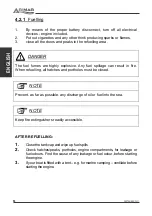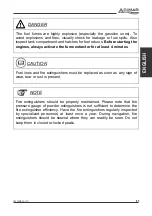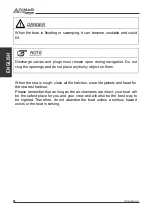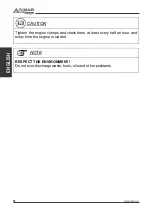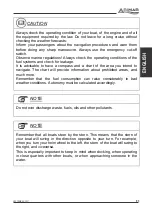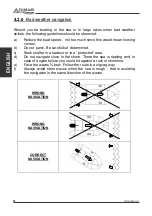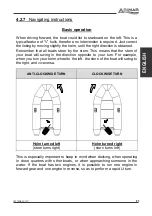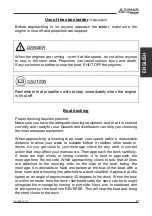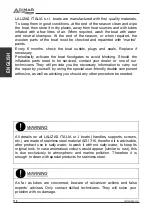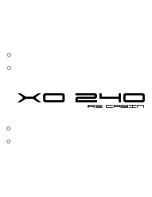
97
SEPTEMBER 2021
ENGLISH
Please note that turning the boat in reverse gear is not the same as turning
in forward gear.
Manoeuvring in narrow areas is more difficult in reverse gear. In short,
when driving in reverse gear, if the helm wheel is turned to the left the stern
will swing to the left and viceversa. If the starboard engine is in forward
gear and the left engine is in reverse, the boat will turn anti-clockwise.
ANTI-CLOCKWISE
TURN IN REVERSE GEAR
CLOCKWISE
TURN IN REVERSE GEAR
Helm turned right
(stern turns right)
Helm turned left
(stern turns left)
To stop the boat, just move the throttle lever backwards to the neutral position.
To stop the boat in a shorter distance, pull the lever backwards to the neutral
position. When the engine is idling, gradually place the shifter in reverse.
As soon as the boat is stopped, bring the throttle lever back to the neutral
position.
Always use extreme caution when approaching someone in the water.
Approach them at idle speed only, allowing your stern to swing away from
them as you get close. Place the shifter in neutral and shut off the boat engine
when you are still several metres from the persons in the water.
Use of the stern ladder
(if equipped)
Before approaching or let anyone approach the ladder, make sure the
engine is shut off and propellers are stopped.
DANGER
When the engines are running - even if at idle speed - do not allow anyone
to stay in the stern area. Propellers can cause serious injury and death.
If any swimmer or bather is near the boat, SHUT OFF the engines.
CAUTION
Remember that propellers will not stop immediately when the engine
is shut off.
Boat docking
Proper docking requires practice.
Make sure you have the adequate mooring equipment, and that it is stowed
correctly and ready for use. Dealers and distributors can help you choosing
the most adequate equipment.
When approaching a mooring area, lower your speed within a reasonable
distance to allow your wake to subside before it reaches other boats or
docks. As you get close to your moorage, check for any wind or current
action that may affect your manoeuvre. Than approach the dock carefully.
If there are high winds or strong currents, it is best to approach the
moorage from the lee side. While approaching, check to see that all lines
are attached to the mooring bitts on the side of the boat facing the
moorage. It is desirable to have one person at the bow of the boat, with a
boat hook and a mooring line attached to a boat cleat/bitt. Approach at idle
speed at an angle of approximately 45 degrees to the dock. When the bow
is within on metre from the dock (starboard side) the stern can be brought
alongside the moorage by turning to port side. Next, turn to starboard and
at idle speed put the boat into REVERSE. This will stop the boat and bring
the stern closer to the dock.


